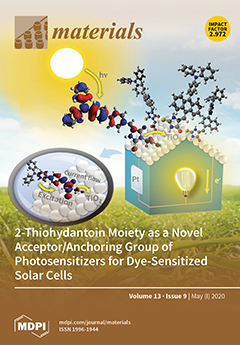This study deals with the CdS/CdTe solar cells under low illumination intensity, with cell #1 for the shunt resistance exceeding 100,000 Ω·cm
2 and cell #2 for the shunt resistance above 1000 Ω·cm
2. The diode parameter variations with the decline of
[...] Read more.
This study deals with the CdS/CdTe solar cells under low illumination intensity, with cell #1 for the shunt resistance exceeding 100,000 Ω·cm
2 and cell #2 for the shunt resistance above 1000 Ω·cm
2. The diode parameter variations with the decline of the irradiance intensity are illustrated by dividing 0–100 mW/cm
−2 into a number of small intensity ranges for J–V measurements and assuming the diode parameters to be constant within each range, the diode parameters of each range including the series resistance, the shunt resistance, the reverse saturation current density and the ideality factor are then extracted by employing an analytical approach. The mechanism of the cell performance deviations are also investigated by basic theories, reports and experiments. For cell #1 with higher
Rsh corresponding to less traps,
Rsh shows a upward tendency as the irradiance declines,
n and
J0 exhibit a rise with the irradiance and keep nearly unchanged at the low irradiance values mainly due to recombination and carrier contributions,
Rs shows a slight increase when the irradiance intensity goes down because of the resistance of CdTe absorption layer. For cell #2 with lower
Rsh corresponding to more traps, with the decrease of the illumination intensity,
Rsh increases sharply only for captured carrier reduction,
Rs goes steadily up similarly,
n and
J0 exhibit a decline with the irradiance due to recombination shift. It should be pointed out that
Rs varies much smoother than the traditional approximation of a reciprocal of differential at short circuit, and the distribution of
Rsh is diverse, and an average
Rsh of for each intensity range can reflect the variation trend.
Full article






